Autopsies released in Twin Peaks biker deaths
Posted: Thursday, August 13, 2015 11:01 am
Autopsy reports on the nine bikers killed in the May 17 Twin Peaks shootout were released Thursday morning by McLennan County Justice of the Peace W.H. “Pete” Peterson’s office.
The melee also injured 20 people and resulted in the arrest of another 177, two of whom remain in the McLennan County Jail after most of the other 175 — all charged with engaging in organized criminal activity — received individual reductions from controversial initial $1 million bonds.
The nine died as a result of one or more bullet wounds, but ballistics reports are not included with the autopsy reports.
Waco Police Chief Brent Stroman said in June that three Waco officers fired a total of 12 rounds that day.
Police have said the ballistics investigation is being headed by the Bureau of Alcohol, Tobacco, Firearms and Explosives, which has possession of more than 475 weapons from the scene, including at least 151 firearms.
The newly released reports do not indicate who killed which men, and most references to bullets refer to projectiles ranging in size from small to large. Gunshot residue kits were submitted for each of the nine killed.
The returned autopsy reports were for:
Daniel Raymond Boyett
Boyett, 44, of Waco, was shot twice in the head and once in the abdomen. Both bullets to his head — one from the top and one from behind — penetrated his scalp and skull. The report says a medical examiner recovered a copper jacket base from one of those bullets. The second bullet to the head was not described. The gunshot wound to Boyett’s abdomen grazed him, leaving copper and lead fragments.
Boyett was wearing a black vest and black boots and had a tattoo that read, “I can do all things through Christ, who strengthens me,” on his right arm.
He had trace amounts of methamphetamine in his system, the report shows.
His Facebook page, deleted May 19, showed numerous photos of him in Cossacks gear and identified him as a regional road captain for the motorcycle club.
Wayne Lee Campbell
Campbell, 43, of Fort Worth, was shot once in the head, with the bullet entering through his chin, exiting and then re-entering through his neck. A medical examiner found five metal, large-caliber, intact bullets in Campbell’s vest pockets, the report says.
Campbell was wearing a black leather vest, black T-shirt, bluejeans, brown boots and metal rings. He had multiple tattoos, including a skull on a woman’s body and “Break this one” with a heart made of bricks on his chest.
The report showed evidence that Campbell had trace amounts of alcohol in his system.
Richard Matthew Jordan II
Jordan, 31, of Pasadena, suffered one gunshot wound to the head. The bullet traveled from back to front, slightly left to right and slightly downward. A severely deformed, medium- to large-caliber, partially jacketed projectile fragment was recovered from the right side of his head and a second, severely deformed, medium- to large-caliber, partially jacketed fragment was recovered from the right side of his neck.
The report shows Jordan also had abrasions on his face and scalp. Jordan tested positive for marijuana on a blood test. The report lists what Jordan was wearing and says five unfired bullets were recovered from the left front pocket of his vest.
He had numerous tattoos, including the word “Lucifer” on his left forearm, and the word “Satan” and an inverted cross on his lower right leg.
Richard Vincent Kirschner Jr.
Kirschner, 47, of Wylie, suffered a gunshot wound to his right thigh, one to the left knee and one in the left buttock. He also suffered a superficial cut to the right side of his neck, a scalp laceration and abrasions to his face, trunk and extremities.
Fragments of a small-caliber bullet were recovered from his left hip. The bullet traveled from back to front and downward. The bullet that struck his right thigh traveled downward, slightly left to right and slightly back to front. Fragments of a jacketed bullet were recovered from his thigh.
Toxicology tests found traces of cocaine and alcohol.
Jacob Lee Rhyne
Rhyne, 39, of Ranger, suffered a gunshot wound to the left side of the neck that partially exited through his upper back and a gunshot wound to the lower abdomen, in addition to abrasions on his right hand.
The report concludes that Rhyne died as a result of the gunshot wound to the neck. That bullet traveled from front to back, left to right and downward, the report shows. Projectile fragments from both gunshot wounds, including copper-colored jacket fragments and white metal fragments, were submitted to the Criminal Investigation Laboratory, the report says.
Jesus Delgado Rodriguez
Rodriguez, 65, of New Braunfels, was shot in the head and in the back. The projectile that was recovered on the left side of his head was not described in the report. The bullet went from front to back and slightly downward.
He also was shot in the right, mid-back. The projectile perforated a rib, his right and left lungs and his heart and exited through his left chest wall. That bullet traveled from right to left, back to front and upward.
Rodriguez tested negative for alcohol or illegal drugs.
Included in a description of what he was wearing was a white metal U.S. Marine Corps tag.
Manuel Issac Rodriguez
Rodriguez, 40, of Allen, suffered one gunshot wound to the head and one in the back. The path of the bullet that struck his head was from front to back, right to left and downward. A severely deformed, apparently medium-caliber, jacketed bullet was recovered from the left side of the neck.
The bullet that struck the right side of his back went from right to left, downward and slightly back to front. A moderately deformed, apparently medium-caliber, jacketed bullet was recovered from the left side of his back.
There was no firearm residue on Rodriguez’s skin, meaning he was not shot at an extremely close range. He also tested negative for alcohol or drugs.
Charles Wayne Russell
Russell, 46, of Tyler, was shot once in the chest. A medium-caliber bullet was recovered from clothing adjacent to an exit wound on the right side of his back. On the base of the bullet is inscribed “15-08020” over “JU”, the report states. The bullet traveled front to back and downward and perforated his sternum, heart, right lung, vertebra and rib.
Russell also suffered lacerations, abrasions and contusions of the scalp, an abrasion on his chin and abrasions to his extremities.
The pathologist found a raffle ticket and a baggie full of a “green, leafy material” in his pants pocket.
Toxicology tests showed Russell tested positive for marijuana and negative for alcohol.
Matthew Mark Smith
Smith, 27, of Keller, had two gunshot wounds — one to his upper back and one to his abdomen. The bullet in his back was described as a “medium-caliber jacketed projectile.” The bullet through his abdomen hit his right kidney and aorta before exiting.
Smith had tattoos of birds on his chest and one of the word “Devotion” on his left wrist, the document says. He was wearing gray jeans, a black vest and a blue cap at the time of the shooting. Smith’s blood tested positive for marijuana.
Vehicle forfeiture documents state that when officers approached the restaurant during the shootout, a Waco police officer saw Jeff Battey and Ray Allen standing behind Twin Peaks “in a triangulated position” to Smith, who was lying on the ground about five yards away and was “gasping for air.” Both Battey and Allen were wearing Bandidos vests.
An officer noticed that Allen had a silver handgun in his hand and said it looked like Battey had been shot in his upper right shoulder, according to the documents.
Battey was arrested upon his release from the hospital the next day. He was the first of the 177 arrested bikers to be released after he posted the full $1 million bond.
Smith’s autopsy report does not specify which of the two gunshot wounds killed him.
------------------------------
From grief to frustration, bikers now have their own theories about what happened at the Waco Twin Peaks shooting.
August 25, 2015 By Jeff Winkler Texas Monthly
“Somebody planted the sonuvabitch.”
That was one organizer’s immediate assessment after a bomb threat forced about 75 bikers and supporters to disperse from in front of the McLennan County courthouse Saturday morning. The bikers had organized a memorial for the nine people killed at the Twin Peaks shooting in Waco three months ago, but the gathering was also supposed to serve as something of a rally for the 177 bikers arrested that day. But now, thanks to a suspicious cooler and a suitcase, the group dissolved.
Clint Broden, the lawyer most publicly associated with the case, was scheduled to speak. And from the sounds of it, Broden’s address could’ve been illuminating if he’d had the chance to give it—”I will have a lot to say soon, I have been saving it up,” he promised on the event flyer.
It’s still unclear what happened on May 17. Most of the national attention the shootout between cops and bikers garnered focused on the two clubs involved, the Bandidos and the Cossacks—essentially turning into PR campaigns for both sides, with law enforcement and bikers offering two very different interpretations of biker culture.
There appears to have been something of a turf war between the ruling Bandidos and the upstart Cossacks, but of the 177 arrested, few had any criminal convictions in Texas. But it’s certainly clear law enforcement had their eye on the Bandidos and the Cossack, having issued a bulletin warning about escalating violence between the two clubs in Texas. The animosity, and sometimes outright wars, between outlaws and the lawmen, has been raging since bikers first hit the road shortly after World War II. Confrontations between clubs with cops are well documented (see: Hunter S. Thompson’s Hell’s Angels). Police have contended that biker gangs run drugs, among other illegal activities. As biking culture has become more mainstream, bikers have argued that their clubs are just that — a group in which like-minded people can talk shop and do what they love.
Details about what happened during this specific shooting, and the subsequent legal issues, are slim. Much of the scarcity of information can be attributed to the courts, which have a gag order in place for all parties involved in the proceedings. The order has been officially protested by a group of sixteen media organizations and is currently in legal limbo, awaiting a decision from the Texas Court of Criminal Appeals.
But that hasn’t put the brakes on personal investigations by club bikers and supporters, which have resulted in a budding patch of uneasy theories. From the conversations at the McLennan courthouse, it’s clear the bikers have developed their own narrative for what really happened, one in line with familiar anti-establishment types. For instance, there were T-shirts that referred to the incident as the “Waco Massacre.”
And there was this couple. When I asked what they were looking at, they said they were trying to figure out how many people were on top of the ALICO, a 22-story building towering over the main square. The suggestion was that there was police surveillance up there (somebody was up on the roof, that’s for sure). Possibly a sniper.
It sounds fantastical, but that’s one of more consistent aspects of the bikers’ explanation of what happened at Twin Peaks. In a nutshell, their story is that the cops planned the whole operation. It was a turkey shoot, they say.
After the bomb threat, the gatherers quickly dispersed (and pretty quietly, for bikers). Some reportedly left town immediately, some congregated in areas just down the street from the courthouse, and others met at the local Harley-Davidson store. I followed John Bostick to Twin Peaks, where a group of about a dozen had gathered.
Bostick, a national administrator for 2 Million Bikers to D.C. who lives in Athens, had organized the twenty-strong crew that rode down from Arlington following an empty white hearse. The group formed in 2013 for two reasons—to “commemorate 9/11 victims and military veterans,” but also to protest the American Muslim Political Action Committee’s . . . rally on the National Mall,” according to Time magazine. As gatherers milled around the Twin Peaks parking lot, the Confederate flag came up, with one biker positing that banning it is destroying history, and that even a black friend he knows isn’t offended by it; another discussed how, contrary to the official story, authorities had actually used explosives during the Waco siege of 1993 with the Branch Dividians. The gathered group doesn’t always have views that the mainstream finds particularly sympathetic.
“Matthew Mark Smith was there,” said Cara Edberg, pointing to the sidewalk behind the now-shuttered Twin Peaks. “You wanna know where people were? I found all nine bodies.” The club supporter had traveled from her home in Longview, Cossack territory, and was guiding others to the spot behind the restaurant where 27-year-old Cossack member Matthew Mark Smith died from gunshot wounds to the stomach and back.
In a way, Smith was being mourned. But as people gathered around Twin Peaks, he seemed to also be a representation of something larger, a catalyst for supporters’ anger, pain, and frustration.
Edberg kept using Matthew Mark Smith’s full name. Said repeatedly, it had the ring of a mourners’ mantra to it. Bending down to the place where the bullet went into the metal siding, people examined it meticulously, expertly. They kept judging the trajectory of the bullets like members of a forensics team on some TV procedural. Everyone was fairly quiet, a bit somber, as they circled the building, inspecting the bullet holes dug into the rock wall and concrete.
“Tell me that bullet hole didn’t come from a high-powered rifle,” said one woman evaluating the crime scene. “Oh hell yeah, it did,” another woman responded. Young kids ran back and forth between the parking lot and the side of the building, repeating the names of the dead.
Mary “Betty Boop” Rodriguez stood beside bullet holes in the concrete, marking the place 65-year-old Purple Heart recipient Jesus Delgado Rodriguez had been shot and killed. Watery-eyed and mostly silent, the widow was surrounded by family. “Mohawk” and “Betty Boop” had been married for forty years.
“I’ve got a couple of the widows that I speak to,” said Edberg. “You know, this is hard; this is a really hard time. They were regular guys. They had families and grandkids on the way.” And the sorrow is turning into bitterness, among other things. “It feels to us almost, like, they portrayed us as trash. Like, we don’t deserve any kind of respect. And that really hurts. I lost my fiancé [who was in a biker club] four years ago. These bikers, they’re all I know. They took care of me and my family. They held me up.”
Anger and the desire for justice seem to be holding the community up too. The bikers explain how a supposed sniper, using a high-powered firearm with a sound suppressor, was atop the adjacent Don Carlos restaurant. And there are plenty of other theories about the incident. On the radio, officers could allegedly be heard saying, “the A side” and “the B side,” of the Twin Peaks building, clear signs, according to Bostick, that they’d “been all over this on the chalkboard for two months [prior].”
Bostick went on to explain part of an hour-long video that’s been making the rounds on the Internet, silent surveillance footage from Don Carlos. One biker was tied and left under the care of a single SWAT member for over an hour before being let go—the cops’s inside man, said Bostick. Then, Bostick pulled up a 59-second cell phone video taken from inside Don Carlos. “If you listen to it, right off the bat, you hear tch-phff, tch-phff, tch-phff.“ That noise, he said, were the “sniper rounds with a suppressor. . . . They started pickin’ them off.” I listened to the video, putting my ear close to his phone. I think I heard it.
Some of these claims seem plausible enough, or, at the very least, not entirely unreasonable. Maybe a couple are hard to follow, and there are aspects to the case that even the bikers disagree about. But the fact is, the lack of official information leaves bikers with only their theories and their anger. Even respected legal writers are frustrated with how things are progressing. At Above the Law, law professor Tamara Tabo laid out exactly why “You Haven’t Heard More About The 177 Bikers Arrested In Waco” (fun fact: the original judge who had set the sweeping, $1 million bail for all those arrested is a former state trooper who thought it was “important to send a message”). And the acclaimed criminal justice blog Grits for Breakfast (recently profiled in Texas Monthly) has highlighted the fact that the “randomly” chosen jury foreman is a current Waco police detective.
So had the cooler planted to break up the memorial, or was it just a coincidence? The bikers’ knee-jerk suspicion might be significantly decreased if authorities had been treating this case with transparency. Confusion and panic during and immediately after the incident were real, and the courts putting everyone in lockdown mode makes some sense (newspapers warned the apocalypse was about to reign down, a horde of bikers en route to the scene). Since the beginning, authorities have advised against listening to what they call conspiracy theories, telling reporters, “We can’t wait to show you what truly happened.” But after three months basic questions about the incident still aren’t being answered, and they should be. Because for the family and friends of the nine dead and the 177 arrested, nothing about this series of events has been easy. Just awful.
More Coverage
- Court of Criminal Appeals stays lower court order in biker gag order
- Visiting judge sets examining trials in biker cases
- DA appeals 10th Court’s ruling on Twin Peaks biker’s case gag order
- Biker objects to postponement of trial, says DA has no case
- Appeals court orders gag order lifted in biker’s Twin Peaks shootout case
- JP Peterson will hand over examining trials to visiting judge
- Updated: List of Twin Peaks bikers jailed, released
- Retired Bosque County judge to hear biker examining trials
- Retired judge sought to hear Twin Peaks bikers’ examining trials
- JP Peterson removed from Hewitt biker’s case
- Hearing set to address JP’s potential recusal from biker case
- Biker rally at courthouse draws about 100
- 1 of 4 jailed bikers likely to be released after hearing
- VIDEO: Don Carlos surveillance footage from Twin Peaks shooting
- Lawsuit alleges Waco biker grand jury conflict of interest
- Only 4 bikers remain jailed in Twin Peaks case; 3 face other charges
- Twin Peaks shootout didn’t dampen robust May sales tax revenues
- Waco police detective named foreman of grand jury that may hear Twin Peaks cases
- Civil rights lawsuit dismissed against city, county; plaintiff plans to refile
- Don Carlos seeks to block release of shootout surveillance video
- Biker attorney challenges ‘cookie-cutter’ arrest warrants
- Judge reverses order to extend McLennan County grand jury’s term
- Biker’s attorney files emergency appeal of gag order
- County hires attorney to help with subpoenas from Twin Peaks shootout
- Grand jury extended 2 months to hear Twin Peaks biker cases
- Judge prevents public release of Twin Peaks video, issues gag order
- Bail bond, ankle monitor companies see bonanza from biker arrests
- Hearing on Twin Peaks video subpoena set for Tuesday
- Waco officials seek to quash subpoena issued for Twin Peaks video
- Bandidos’ attorney: Police account of Twin Peaks shooting ‘false,’ ‘damaging’
- Answers and evidence in Twin Peaks shootout delayed by case complexity, police caution
- Vehicle forfeiture documents reveal new details about deadly biker shootout
- Details: 27 vehicle forfeiture petitions filed in Twin Peaks shootout
- Police release more details, numbers in Twin Peaks shooting
- More bikers in court for bond-reduction hearings
- Bandido shot in Twin Peaks shootout testifies at hearing
- County starts 2016 budget talks, prepares for impact of biker arrests
- Court system stressed by bikers’ arrests, judges to brainstorm expediting cases
- Hundreds of bikers protest at McLennan County courthouse
- Bill Mahon, guest columnist: Cossacks, Bandidos, law enforcement and district attorney all to blame for Twin Peaks gunfire, lockups
- Released bikers give clashing accounts of Twin Peaks shootout
- LETTERS: Readers sound off about cowboy justice, gun rights, meat and poultry standards and the Waco ISD Track & Field Complex
- Courthouse, downtown officials gear up for Sunday biker rally
- Prosecutor details ‘executions’ at Twin Peaks during hearing
- State commission inspects jails in wake of biker complaints
- Visiting judge denies motion to recuse local judges in biker cases
- 25 bikers released since start of bond negotiations
- Dallas lawyer files complaint against JP Peterson over biker bonds
- Bikers’ attorneys battle over fake litigation waiver rumors
- Bikers put out call to action, start letter-writing campaign
- Three more bikers released on reduced bonds
- Hewitt biker files civil rights lawsuit over Twin Peaks arrest
- Experts debate marketability of former Twin Peaks building
- Bikers released after bond reduction agreements with DA
- EDITORIAL: Local criminal justice system, Texas biker confederation both have some work to do
- LETTERS: Two readers speak for innocents jailed in Twin Peaks shooting melee
- Stuck behind bars: Families await biker releases as lawyers claim innocence
- County expenses in biker cases could have major budget impact
- Biker attorney seeks to replace judges, demands immediate release of clients
- Police clear Twin Peaks site as crime scene
- Vehicle forfeiture efforts could be lucrative, but difficult in Twin Peaks shooting
- Bill Whitaker: Waco biker brawl excites some media but few others
- EDITORIAL: Crisis past, let’s regroup this weekend to regain our footing, ensure justice
- Mike Copeland: HGTV couple donates to Waco police; new Haverty’s furniture store opens
- Eyewitness account of Twin Peaks shooting: 'a setup from start to finish'
- Funeral held in Plano for biker killed at Twin Peaks
- About 20 motorcyclists protest mass incarceration of biker suspects
- Texas House passes biker safety bill days after shooting
- Biker group gets proclamation from Waco City Council
- County seeks help with shortage of attorneys in Twin Peaks case
- McLennan Co. Sheriff taking law enforcement threats seriously
- John Fletcher, guest columnist: Once again, Waco wrestles with a tragedy beyond its imagination or control
- LETTERS: Two views on the Twin Peaks shootout in Waco
- Search warrants yield plethora of Bandidos, Cossacks symbols
- Purple Heart recipient among bikers killed in Waco shooting
- Twin Peaks shooting causes biker events to be canceled
- AP: Majority of 170 bikers arrested have no convictions in Texas
- Don Carlos suing Twin Peaks’ owners over biker gang shootout
- LETTERS: Our readers sound off on Sunday’s shootout at Twin Peaks
- NEW: Where suspects charged in Twin Peaks shootout live
- Arrest in Twin Peaks shootout costs ex-San Antonio cop his job
- Friends, family claim some arrested bikers shouldn’t be jailed
- Bikers, others flee gunfire in Waco restaurant video
- Hosts of biker events reconsider after deadly Waco shootout
- Officials find hundreds of weapons, describe surreal scene inside Twin Peaks
- At least one Twin Peaks suspect posts $1 million bond, required to wear ankle monitor
- Jailed biker suspects in Twin Peaks shooting from across state
- Central Texas Marketplace stores reopen to curious, grateful crowds
- Some see difference between perceptions of Waco, Ferguson, Baltimore
- Wife of biker inmate: Some arrested in Waco are innocent
- EDITORIAL: Twin Peaks shootout demonstrates more of us are in the news media than you might think
- LETTERS: Our readers sound off on the Twin Peaks shootout
- Stores around Twin Peaks remain closed, part of crime scene
- 3 motorcycle gang members turn themselves in after mistake led to release
- Only 1 of 9 slain in Twin Peaks shootout from Waco; Witnesses say Cossacks instigated
- EDITORIAL: Deadly Twin Peaks biker-gang shootout shouldn’t define Waco, its people, its progress
- LETTERS: Readers sound off on Twin Peaks shootout
- Memo: Violence long simmered between rival Texas biker gangs
- Brutal violence at Twin Peaks exposes fault lines in motorcycle world
- Waco shootout puts spotlight on motorcycle club culture
- Waco shootout becomes flashpoint in Texas open carry debate
- Twin Peaks permanently closes Waco location
- Bikers jailed under $1 million bonds; one bond-reduction hearing set
- Booking 170-plus inmates ‘slow and tedious process’; Rival gangs separated at jail
- Shootout shocks Waco residents
- Biker gang shootout leaves 9 dead, 18 wounded, ongoing investigation
- Statement by operating partner of Twin Peaks franchise in Waco
- UPDATES: Police believe five motorcyle gangs involved in deadly Twin Peaks shootout
- Judge rules Twin Peaks biker, wife jailed with sufficient probable cause
- Appeals court rules two bikers were jailed with sufficient probable cause
- Bomb scare ends downtown Waco biker rally early
- Judge rules probable cause to arrest Bandidos chaplain
- Customers sue Twin Peaks over deadly shootout
- DPS report details gang threats in Waco area, Texas
- Warrant seeks bullet from arm of Twin Peaks biker killed in deer collision
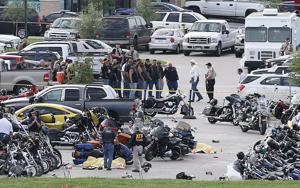
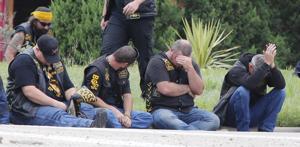
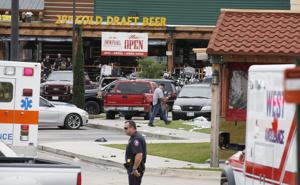
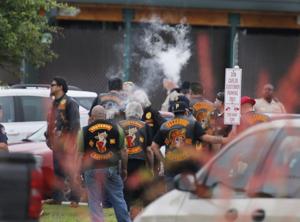
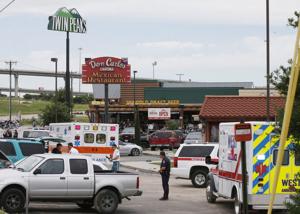
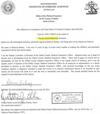
* 9 dead - 18 wounded
ReplyDelete* No ballistics identifying the weapons released
* Not releasing the calibers of the bullets - Why?
* Waco Police Chief Brent Stroman said in June that three Waco officers fired a total of 12 rounds that day
* Why did the Waco Police presume to know all these men and the 177 arrested were violent criminals when the facts show otherwise?
* A lot of downward trajectories to the wounds - that usually implies rounds were fired from a higher elevation - Snipers?
* There were seventeen gunshot wounds described in the autopsy reports - All of the victims had entrance wounds of 1/4 in diameter or less (consistent with police rifle ammunition)
* 3 cops opened fire with 223 assault rifles
* No evidence was presented that any of the wounds were inflicted at close range
* One of the seventeen gunshot wounds was a superficial graze wound
* Eleven of the remaining sixteen wounds had a downward trajectory, and ten of them were back to front
This morning there are numerous stories that a biker died in an unrelated accident. The biker had a bullet in his arm from the Waco incident. Now the police wants his arm.
ReplyDeleteSearch Results
Story image for waco twin peaks from WFAA
Authorities seek bullet lodged in Twin Peaks shooting suspect's body
WFAA-Sep 10, 2015
McLellan Co. detectives say one injured biker slipped away from the chaos after the Waco Twin Peaks shooting without being identified or ...
Bullet Removed From Arm Of Dead Twin Peaks Biker Sent To ATF
KWTX-14 hours ago
Wounded biker who evaded arrest in Twin Peaks shootout to have ...
New York Daily News-14 hours ago
Detectives seek bullet lodged in Waco, Texas, shooting suspect’s body
USA TODAY-19 hours ago
Bullet sought from arm of Henderson biker tied to Waco shootout
Longview News-Journal-Sep 11, 2015
Warrant seeks bullet from arm of Twin Peaks biker killed in deer ..
.
Highly Cited-Waco Tribune-Herald-Sep 9, 2015